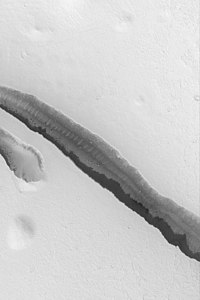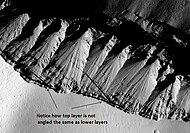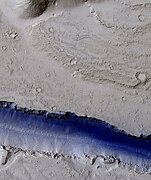Cerberus Fossae
 A 3km section of a Cerberus Fossae fissure, taken by the Mars Global Surveyor (MGS) Mars Orbiter Camera (MOC) | |
| Coordinates | 11°54′N 188°48′W / 11.9°N 188.8°W / 11.9; -188.8Coordinates: 11°54′N 188°48′W / 11.9°N 188.8°W / 11.9; -188.8 |
|---|---|
| Length | 1,630.0 km |
| Naming | From albedo feature at 10n, 212W. Changed from Cerberus Rupes. |
The Cerberus Fossae are a series of semi-parallel fissures on Mars formed by faults which pulled the crust apart in the Cerberus region. They are 1235 km across and centered at 11.28 °N and 166.37 °W.
Their northernmost latitude is 16.16 °N and their southernmost latitude 6.23 °N. Their easternmost and westernmost longitudes are 174.72 °E and 154.43 °E, respectively. They can be seen in the Elysium quadrangle.[1]
Ripples seen at the bottom of the faults are sand blown by the wind.[2]
Numerical modeling of the forces in the crust of Mars suggest that the underlying cause for the faulting is the deformation caused by the Tharsis volcanoes to the east. The faults are quite young, cutting through pre-existing features such as the hills of the Tartarus Montes and the lava apron southeast of Elysium Mons.[3] The formation of the fossae was suspected to have released pressurized underground water, previously confined by the cryosphere, with flow rates up to 2 × 106 m3s−1, leading to the creation of the Athabasca Valles.[4][5][6] Marte Vallis is another channel that was suggested to have formed from water released from Cerberus Fossae.[7]
However, continued investigation has shown that there is no plausible way to provide such high discharges of water to the surface through these fissures. Instead, lava was the fluid erupted from the Cerberus Fossae. The flood of lava had a volume of about 5000 cubic kilometers, quite typical of flood basalt eruptions on Earth. At these high discharges, lava behaved in many ways like a flood of water. It appears to have modestly eroded parts of Athabasca Valles and then filled the Cerberus Palus basin. The rafted plates of lava in this 800 km (500 mi) by 900 km (560 mi) temporary lava pond are remarkably similar in appearance to pack ice seen in the North Sea.[8] Crater counts suggest this last eruption from the Cerberus Fossae took place about 2 to 10 million years ago.
The Cerberus Fossae, as seen from THEMIS.
Cerberus Fossae dark emission of dark material, as seen by HiRISE. Narrow band of material is coming out of the trough. Scale bar is 500 meters long.
Cerberus Fossae, as seen by HiRISE.
Angular unconformity in the Cerberus Fossae, as seen by HiRISE. Click on image to see the angles of the layers.
Portion of a trough (fossa) in Elysium, as seen by HiRISE under the HiWish program. Blue indicates probably seasonal frost.
See also
- Fossa (geology)
- Geology of Mars
- HiRISE
- HiWish
- Lakes on Mars
References
^ "Cerberus Fossae". Gazetteer of Planetary Nomenclature. USGS Astrogeology Science Center. Retrieved 2018-05-07..mw-parser-output cite.citation{font-style:inherit}.mw-parser-output q{quotes:"""""""'""'"}.mw-parser-output code.cs1-code{color:inherit;background:inherit;border:inherit;padding:inherit}.mw-parser-output .cs1-lock-free a{background:url("//upload.wikimedia.org/wikipedia/commons/thumb/6/65/Lock-green.svg/9px-Lock-green.svg.png")no-repeat;background-position:right .1em center}.mw-parser-output .cs1-lock-limited a,.mw-parser-output .cs1-lock-registration a{background:url("//upload.wikimedia.org/wikipedia/commons/thumb/d/d6/Lock-gray-alt-2.svg/9px-Lock-gray-alt-2.svg.png")no-repeat;background-position:right .1em center}.mw-parser-output .cs1-lock-subscription a{background:url("//upload.wikimedia.org/wikipedia/commons/thumb/a/aa/Lock-red-alt-2.svg/9px-Lock-red-alt-2.svg.png")no-repeat;background-position:right .1em center}.mw-parser-output .cs1-subscription,.mw-parser-output .cs1-registration{color:#555}.mw-parser-output .cs1-subscription span,.mw-parser-output .cs1-registration span{border-bottom:1px dotted;cursor:help}.mw-parser-output .cs1-hidden-error{display:none;font-size:100%}.mw-parser-output .cs1-visible-error{font-size:100%}.mw-parser-output .cs1-subscription,.mw-parser-output .cs1-registration,.mw-parser-output .cs1-format{font-size:95%}.mw-parser-output .cs1-kern-left,.mw-parser-output .cs1-kern-wl-left{padding-left:0.2em}.mw-parser-output .cs1-kern-right,.mw-parser-output .cs1-kern-wl-right{padding-right:0.2em}
^ "Cerberus Fossae Trough". Nasa.gov. Nasa. Retrieved 19 April 2014.
^ "Cerberus Fossae". Asu.edu. Arizona State University. Retrieved 19 April 2014.
^ James W. Head; Lionel Wilson; Karl L. Mitchell (2003). "Generation of recent massive water floods at Cerberus Fossae, Mars by dike emplacement, cryospheric cracking, and confined aquifer groundwater release". Geophysical Research Letters. 30 (11): 2265. Bibcode:2003GeoRL..30.1577H. doi:10.1029/2003GL017135.
^ Cabrol, N. and E. Grin (eds.). 2010. Lakes on Mars. Elsevier. NY
^ Burr, D. et al. 2002. Repeated aqueous flooding from the Cerberus Fossae: evidence for very recently extant deep groundwater on Mars. Icarus. 159: 53-73.
^ Gareth, A. B. Campbell, L. Carter, J. Plaut, R. Phillips. 2013. 3D Reconstruction of the Source and Scale of Buried Young Flood Channels on Mars. Science, March 7, DOI:10.1126/Science.1234787
^ Young, Kelly (2005-02-25). "'Pack ice' suggests frozen sea on Mars". New Scientist. Retrieved 2007-01-30.




